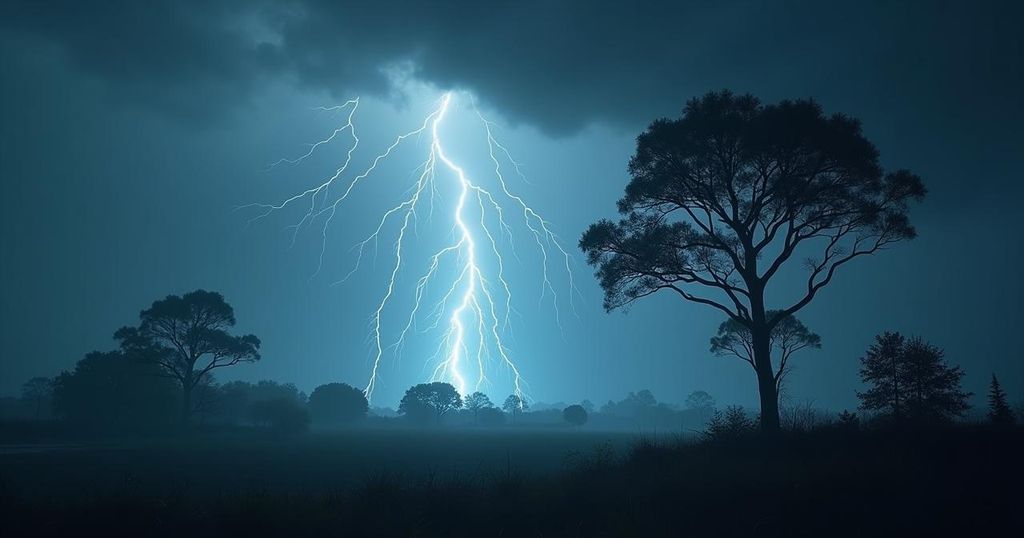Unprecedented Rainfall in the Southeast U.S. Linked to Climate Change Effects
Over 40 trillion gallons of rain fell across the Southeast U.S. due to Hurricane Helene and an additional rainstorm, resulting in catastrophic flooding and over 100 fatalities. Meteorologists suggest the rain quantity is unprecedented and likely exacerbated by climate change, highlighting trends of increasing storm intensity and moisture retention in the atmosphere.
Recently, the Southeast United States has experienced an unprecedented deluge, with more than 40 trillion gallons of rain falling across the region due to Hurricane Helene and an additional rainstorm that preceded it. This staggering volume of water is sufficient to fill the Dallas Cowboys’ stadium 51,000 times or one could say it could occupy Lake Tahoe just once. In North Carolina alone, if all this rain was concentrated, it would create a depth of 3.5 feet (more than 1 meter) of water across the state, which equates to filling over 60 million Olympic-size swimming pools. “That’s an astronomical amount of precipitation,” stated Ed Clark, the head of the National Oceanic and Atmospheric Administration’s National Water Center in Tuscaloosa, Alabama. “I have not seen something in my 25 years of working at the weather service that is this geographically large of an extent and the sheer volume of water that fell from the sky.” The flooding caused by this rain has resulted in catastrophic damage, with over 100 fatalities reported. According to private meteorologist Ryan Maue, a significant portion of this rainfall—around 20 trillion gallons—occurred in states such as Georgia, Tennessee, the Carolinas, and Florida as a direct consequence of Hurricane Helene. He calculated this using satellite measurements and ground observations across a vast area. The sheer size of the rainfall is approximately double the combined storage capacity of Lake Powell and Lake Mead, two crucial reservoirs in the Colorado River basin. Meteorologists noted that this event was generated from a mix of two or three storm systems. Before Hurricane Helene’s arrival, a low-pressure system had stalled over the Southeast, drawing warm waters from the Gulf of Mexico. Additionally, a lesser storm lingered off the North Carolina coast, contributing further to the heavy rainfall by dropping as much as 20 inches in certain areas, according to North Carolina state climatologist Kathie Dello. The unique topography affected by these storms exacerbated the rainfall. The interaction of the storm systems with the mountains increased moisture extraction from the air. North Carolina weather officials reported a top measurement total of 31.33 inches in Busick, while Mount Mitchell experienced over 2 feet of rainfall. In light of recent weather patterns, Ed Clark reflected, “Before 2017’s Hurricane Harvey, I said to our colleagues, you know, I never thought in my career that we would measure rainfall in feet… We’re seeing events year in and year out where we are measuring rainfall in feet.” The trend indicates an increase in precipitation associated with climate change, according to meteorologists like Kristen Corbosiero and Kathie Dello. The science suggests that warmer air holds approximately 4% more moisture for every degree Fahrenheit rise in temperature, and the world has warmed over 2 degrees (1.2 degrees Celsius) since pre-industrial times. Notably, recent analyses indicate that climate change has led to a 50% increase in rainfall during Helene in parts of Georgia and the Carolinas. Dello emphasized the clear influence of climate change on recent storm intensity, stating, “We’ve seen tropical storm impacts in western North Carolina… but these storms are wetter and these storms are warmer. It would have been a time when a tropical storm would have been heading toward North Carolina and would have caused some rain and some damage, but not apocalyptic destruction.”
This article highlights the severe impact of Hurricane Helene and the accompanying rainstorm on the Southeast United States, delivering an exceptional quantity of rainfall that has caused considerable destruction and loss of life. Meteorological experts provide insights into the extent of this phenomenon, linking it to broader discussions on climate change and the increasing intensity of weather events. Their calculations suggest this type of rainfall is becoming more common, indicating a crucial change in weather patterns driven by global warming.
In summary, the recent rainfall in the Southeast United States, exacerbated by Hurricane Helene and preceding storm systems, has led to catastrophic flooding and loss of life. Experts emphasize that the magnitude of this event is linked not only to meteorological conditions but also to ongoing climate change. The alarming trends in precipitation frequency and intensity underline the urgent necessity for society to address these issues that pose significant risks to safety and infrastructure.
Original Source: www.pbs.org




Post Comment